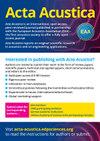两种混合声音预测方法在涡轮增压器压气机管道内吸声器评估中的适用性
IF 1.4
3区 物理与天体物理
Q4 ACOUSTICS
引用次数: 4
摘要
本文分析了Ffowcs-Williams和Hawking方法与基于有限元法求解可压缩流动的Lighthill气动声波方程的一种新的声音传播方法的区别。此外,我们还讨论了两种方法的适用性。基于Lighthill方程的声音传播方法引入了一个流动界面边界条件,类似于Ffowcs-Williams和Hawking类比中的可渗透边界,它允许在传播域中省略复杂的几何形状。这样可以减少数字工作量和存储需求。因此,考虑了混合气动声学工作流,其中气动声源项计算耦合流动和分离声传播模拟。我们在提出的Lighthill方程的弱公式的意义上对Lighthill的源项进行了广泛的研究。为了验证,使用了来自冷气体试验台的测量结果。此外,讨论了应用两种声音传播方法来研究谐振器和吸声器的影响的可能性。本文章由计算机程序翻译,如有差异,请以英文原文为准。
Applicability of two hybrid sound prediction methods for assessing in-duct sound absorbers of turbocharger compressors
We analyze the differences between the Ffowcs–Williams and Hawking’s approach and a new sound propagation approach based on the finite element method used for solving Lighthill’s aeroacoustic wave equation for compressible flows. In addition, we discuss the applicability of both methods. The sound propagation approach based on Lighthill’s equation introduces a flow-interface boundary condition, similar to permeable boundaries in the Ffowcs–Williams and Hawking’s analogy, which allows the omission of complex geometries in propagation domains. This enables to reduce numeric effort and storage requirements. Thereby, the hybrid aeroacoustic workflow is considered, for which aeroacoustic source terms are computed to couple a flow and a separated acoustic propagation simulation. We present an extensive investigation of Lighthill’s source terms in the sense of the proposed weak formulation of Lighthill’s equation. For validation, measurements from a cold gas test rig are used. In addition, the possibilities of applying both sound propagation methods for investigating the influence of resonators and sound absorbers are discussed.
求助全文
通过发布文献求助,成功后即可免费获取论文全文。
去求助
来源期刊

Acta Acustica
ACOUSTICS-
CiteScore
2.80
自引率
21.40%
发文量
0
审稿时长
12 weeks
期刊介绍:
Acta Acustica, the Journal of the European Acoustics Association (EAA).
After the publication of its Journal Acta Acustica from 1993 to 1995, the EAA published Acta Acustica united with Acustica from 1996 to 2019. From 2020, the EAA decided to publish a journal in full Open Access. See Article Processing charges.
Acta Acustica reports on original scientific research in acoustics and on engineering applications. The journal considers review papers, scientific papers, technical and applied papers, short communications, letters to the editor. From time to time, special issues and review articles are also published. For book reviews or doctoral thesis abstracts, please contact the Editor in Chief.
 求助内容:
求助内容: 应助结果提醒方式:
应助结果提醒方式:


